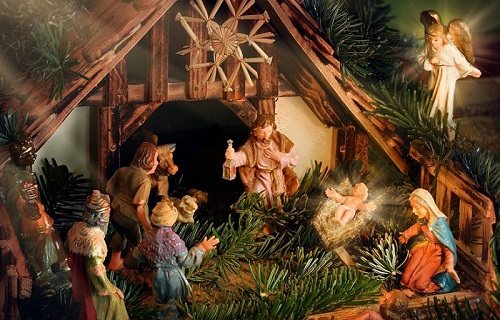Tweet
Christmas is the most important and joyful Christian holiday. After all, it glorifies the birth of Man and God in one person, Jesus Christ. It is celebrated on January 6th. The night before Christmas is considered magical. And if you make a kind, sweet, wise wish on this night, it will definitely come true.
After all, it was love, kindness and wisdom that Jesus Christ taught people.
This holiday is celebrated by the whole family, so children should know its history, traditions, and customs.
Today we will tell the story of the Nativity of Christ for children.
The story of the birth of Jesus, the story of Christmas for children
Jesus' parents were Mary and Joseph. Although in fact the father of Jesus is the Lord God, Joseph was entrusted with the mission of raising the son of God.
The Virgin Mary and her husband, Joseph, lived in the town of Nazareth. Because of the Roman Empire's census, they were forced to go to Bethlehem. There were many people in Bethlehem who had arrived for the census, all the houses and hotels were occupied, so Mary and Joseph had to spend the night in a cave, which the shepherds used to shelter their livestock from the weather. It was in it that Jesus was born - the One who was destined to become the Savior of the world.
Since there was no crib in the cave, the parents put the baby directly in a manger, a special box from which animals eat. It was just filled with hay.
Shepherds with their flock passed near the cave. They saw a bright light and an angel. An angel announced to them about the birth of Christ, who came to earth to save the world from sins. The angel told the shepherds how to find the Baby.
The shepherds left their flocks and went towards Bethlehem, where they found the Virgin Mary, Joseph and the Baby in a manger in a cave.
And at this time, somewhere in the east, three wise men, who were called the Magi, saw the bright star of Bethlehem in the sky, which showed them the way to the newborn baby. They knew that the Savior, who was destined to become the King of Heaven on earth, would soon come to the world, and they went to him with gifts (gold, incense, myrrh).
The reigning king at that time, Herod, having heard the news of the birth of a new king, was afraid that he might replace him on the throne, so he ordered to kill all the babies in the city. But Jesus was no longer in the city at that moment. An angel appeared to Joseph and said: “Get up, take the Child and His Mother and flee to Egypt, and remain there until I tell you, for Herod wants to look for the Child in order to destroy Him.” Thus, the Son of God miraculously managed to survive.
Innovation Competition in Education
KIvo is also on the Map of Leaders of Innovation in Education, since it itself is an innovation, a startup. “We developed it according to a scheme familiar to all beginning entrepreneurs,” says KIvo director Diana Koroleva. “But very soon the competition also became a testing ground for research, and we managed to collect a solid database.” Thanks to KIvo, the Center for the Study of Innovation in Education was created at the Higher School of Economics, which explores topics such as the landscape of the educational innovation market, the characteristics of teams of innovative projects and the characteristics of innovators themselves.
Miracle of Christmas
The miracle of Christmas is that for the first and only time, the immaculate Virgin gave birth to a Child. The news of the birth of Jesus, the Son of God, was brought by an Angel. From that moment on, Mary and her betrothed Joseph eagerly awaited God's child.
Therefore, it is believed that at Christmas the heavens open and you can ask them for anything. The main thing is that the desire is kind, sincere and bright. On the night before and on Christmas, miracles happen: people are healed of illnesses, their dreams come true. You only need to believe in a miracle with all your heart.
A story about Christmas for children needs to be supplemented with holiday symbols.
“Moscow through the eyes of an engineer” (winner of KIVO-2015)
Excursions, lectures and children's master classes about architectural monuments, how the city works from an engineer's point of view. Children learn design work skills and an engineering way of thinking. Since 2014, the project has been at the top of the TripAdvisor rating among entertainment companies in Moscow. Project author Airat Bagautdinov advises future KIvo participants not to focus on trying to win, but to make the most of the competition environment to find a partner or investor.
Symbols of the Nativity of Christ
Nativity scene
The direct meaning of the word is cave. The Nativity scene is the cave in which Jesus Christ was born.
The figurative meaning of the word Nativity scene is a reproduction of the Nativity scene using art. This could be a stage performance depicting the birth of the Child Jesus Christ.

Bethlehem Christmas star
The Bethlehem Christmas Star is an eight-pointed Star that appeared in the sky at the moment of the birth of Jesus Christ and showed the way to the wise men to the cave. The Star of Bethlehem symbolizes the good news of the birth of Christ.

Magi
Magi are sages whose power lay in the knowledge of secrets inaccessible to ordinary people.
Gifts of the Magi
The Gifts of the Magi are the three gifts they gave to Jesus: gold, frankincense and myrrh. Each of them has its own symbolic power:
* Gold is a gift that shows that Jesus was born to be King.
* Frankincense is a gift to the priest, because Jesus was to become the new Teacher and High Priest.
* Myrrh is a gift to someone who is about to die, it was used to embalm the body of the deceased.

Christ's manger
The manger of Christ is a feeding trough for domestic animals, in which Mary placed the newborn baby, as if in a cradle.
Christmas Eve
Christmas Eve - January 6th. On Christmas Eve, Orthodox Christians prepare for the upcoming holiday.
Kutya, sochivo
Sweet kutia, made from wheat, rice or other grains, is a real treat for children. On Christmas Eve they prepare Lenten kutya or, as it is also called, sochivo. Sochivo is a lean dish made from rice or wheat with the addition of honey, raisins, candied fruits and candied fruits.
Children about Christmas, Christmas traditions
Fasting before Christmas
It is customary to fast 40 days before Christmas. It is needed to cleanse the body and soul. During the period of fasting, you cannot eat certain foods, including meat, as well as quarrel, get angry, and be offended. Fasting is needed precisely so that everyone becomes a little kinder.

Christmas Eve
The last day of Lent and the evening before Christmas is usually called Christmas Eve. Its name comes from the name of the dish - sochivo, which is prepared from cereals - rice, barley, wheat. Cereals are boiled and soaked with poppy seeds, nuts, fruits, raisins, candied fruits, and honey.
There should be 12 Lenten dishes on the table on Christmas Eve, as many as Jesus had apostles.
The Story of Christmas Eve
Once upon a time, people began to celebrate Christmas on January 6th. Mom prepared 12 Lenten dishes, and the children waited for the first star to appear in the sky. As soon as she appeared, Christmas Eve began. Then the father brought hay into the house and laid it on the table. After all, it was on the hay that little Jesus was laid. A small nest was made from hay, in which a pot of kutia (sochivo) was placed.
Before dinner, they lit a candle and prayed together. Only after prayer could dinner begin.
Kutya (sochivo) is the most important dish on the table. In addition to kutya, they served fish, cabbage rolls, pies with cabbage, pancakes... The food was washed down with uzvar. For dessert they baked pies with poppy seed filling.
After Christmas Eve, the children went to their godparents, brought dinner (bread and salt, kutya, rolls), and they treated the kids, gave them candy and money.
On Christmas night it was customary to carol. Children, youth and everyone else went to the houses of neighbors and relatives, sang carols, wishing them good health and prosperity. In return, the owners gave the carolers sweets and coins. It was believed that the more carolers who come to the house, the more joy there will be this year.
And on Christmas Eve they showed a nativity scene - a performance about the birth of Jesus.

Christmas tree decoration
The Bethlehem guiding star has long been considered a traditional Christmas tree decoration, which is attached to the top of the tree. In ancient times, the Christmas tree was decorated with paper figures and flowers, apples, and sugar. The tradition of decorating a Christmas tree is associated with the tree of paradise, hung with apples.
Christmas presents
In memory of the gifts that the wise men brought to Jesus, they give each other gifts at Christmas. Read about what you can give for Christmas here:
What to Give Grandma for Christmas, 135 Gifts for Grandma for Christmas
What to give for Christmas
What to give for Christmas - a girl, a guy, a child, a man, a woman?
Christmas gifts for parents: interesting options
Christmastide
Christmastide begins with Christmas - holidays that last until Epiphany Eve and are accompanied by mass festivities, visits to relatives and friends.
Interesting science facts for kids
Some parents tell their child: “You are the light of my life.” But did you know that if you were light, you would fly around the entire globe 7.5 times per second! If you became sound, you could fly around the Earth in 4 hours! If we lived on Jupiter, our day would consist of only 9 hours. It’s good that on Earth a day lasts 24 hours, because we have so much to do during the day! These are just a few fun scientific facts that may interest both an inquisitive child and an adult.
What is science?
Science is an organized and sequential study that includes observation, collection of scientific facts, experimentation, testing of results, and explanation of natural and man-made phenomena. This is an area that gives us the opportunity to better understand the world around us and create good things for the benefit of man and all living beings.
Ordinary scientific facts
Now that you know what we're talking about, here are some fun scientific facts:
- If you stretch a human DNA chain, its length will be the distance from Pluto to the Sun and back.
- When a person sneezes, the speed of the air they exhale is about 160 km/h.
- A flea can jump to a height that is 130 times its own height. If the flea were a 1.80 m tall person, it could jump 230 m.
- The electric eel produces an electrical current of 650 volts. Touching it is the most powerful shock a person can experience.
- Light particles called photons take 40,000 years to travel from the Sun's core to its surface, but only 8 minutes to reach Earth.
Scientific facts about the Earth
Earth is our home. To take care of her, we need to know important information about her:
- The age of the Earth is from 5 to 6 billion years. The Moon and the Sun are about the same age.
- Our planet is composed mainly of iron, silicon and relatively small amounts of magnesium.
- Earth is the only planet in the solar system with water on its surface, and its atmosphere is 21% oxygen.
- The Earth's surface is made up of tectonic plates located on the mantle, a layer located between the Earth's core and the surface. This structure of the earth's surface explains earthquakes and volcanic eruptions.
- There are about 8.7 million species of living organisms living on Earth. Of these, 2.2 million species live in the ocean, and the rest live on land.
- ¾ of the Earth's surface is covered with water. When astronauts first saw Earth from space, they saw mostly water. This is where the name “blue planet” comes from.
Environmental Facts
Why do the seasons change? What happens to garbage after we throw it away? What causes the weather to be hot or cool? Children learn this and much more in natural history lessons at school. Let's look at some facts that convince us of what a beautiful planet we live on.
- Plastic completely decomposes in the ground in 450 years, and glass in 4,000 years.
- Every day around the world, 27,000 trees are used to make toilet paper alone.
- 97% of all water on Earth is salty and unsuitable for consumption. 2% of the water is in glaciers. Therefore, only 1% of water is suitable for consumption.
- The meat processing industry is the biggest contributor to global warming. In second place among global problems is deforestation. About 68% of existing plant species are likely to become extinct in the near future.
- The population of the Earth is more than 7 billion people. This figure is expected to reach 8 billion by 2025.
- Unfortunately, 99% of existing species of living organisms, according to scientists, will become extinct.
Interesting facts about animals
The animal kingdom is beautiful and amazing. It contains tame otters, powerful eels, singing whales, giggling rats, oysters that change gender, and many other equally amazing representatives. Here are a few facts about animals that your child will undoubtedly enjoy:
- Octopuses have three hearts. An even weirder fact: lobsters have a urinary tract on their face, while turtles breathe through their anus.
- In seahorses, males give birth, not females.
- The kakapo parrot has a strong, pungent odor that attracts predators. That is why kakapo are in danger of extinction.
- A squirrel plants more trees than the average person in a lifetime. How can this be? The fact is that squirrels hide acorns and nuts underground, and then forget where exactly they hid them.
- It is mainly lionesses who hunt among lions. Leos only intervene when necessary.
Interesting facts about plants
Plants green our planet, produce oxygen, and make the Earth habitable. Trees and plants are probably the most useful among the living inhabitants of the Earth. Here are some interesting facts about plants:
- Like humans, plants recognize other plants of their own species.
- In total, there are more than 80,000 edible plants on Earth. Of these, we eat about 30.
- Humanity is rapidly destroying forests. About 80% of all forests have already been destroyed.
- The oldest tree in the world (sequoia) is located in the USA, in the state of California. His age is 4,843 years.
- The height of the tallest tree in the world is 113 m. It is also located in California.
- The largest tree in the world is aspen, growing in the USA, in the state of Utah. Its weight is 6,000 tons.
Facts about space
The sun, stars, planets, the Milky Way, constellations and everything that is in the Universe is located in vacuum space. We call it space. Here are some interesting facts about him:
- The Earth is tiny compared to the Sun, which is 300,000 times larger.
- The entire space is absolutely silent, because sound does not travel in a vacuum.
- Venus is the hottest planet in the solar system. The temperature on the surface of Venus is 450°C.
- The force of gravity changes a person's weight on different planets. For example, the force of gravity on Mars is lower than on Earth, so a person weighing 80 kg on Mars would weigh only 31 kg.
- Since the Moon has neither atmosphere nor water, nothing can erase the traces of astronauts who set foot on its surface. Therefore, the traces will probably remain here for another hundred million years.
- The temperature of the Sun's core, the closest star to Earth, is 15 million degrees Celsius.
Facts about famous scientists
For a long time, people thought that the Earth was flat, that the change of seasons depended on the mood of the gods, and that illness was caused by evil spirits. This continued until great scientists proved the opposite. Without them, we would still be living in ignorance.
- Albert Einstein was a genius, but his talents were discovered quite late. After the scientist's death, his brain was the subject of numerous studies.
- Nicolaus Copernicus disproved the theory that the Earth is the center of the Universe. He developed a model of the solar system with the Sun at the center.
- Leonardo da Vinci was not only an artist. He was also an outstanding mathematician, scientist, writer and even musician.
- Archimedes invented the law of fluid displacement while taking a bath. The funny thing is that, according to legend, he jumped out of the bathtub shouting “Eureka!” He was so excited that he forgot that he had no clothes on.
- Marie Curie, the female chemist who discovered radium, was the first person in the world to win the Nobel Prize twice.
Scientific facts from the world of technology
Technology is the engine of progress. We are so dependent on technology in everyday life that it is even scary. Here are some interesting facts about the technical devices we come across every day:
- The first computer game appeared in 1967. It was called “brown box” (translated from English as “brown box”) because that’s exactly what it looked like.
- The world's first computer, ENIAC, weighed more than 27 tons and took up an entire room.
- The Internet and the World Wide Web are not the same thing.
- Robotics is one of the most relevant scientific fields today. However, back in 1495, Leonardo da Vinci drew the world's first diagram of a robot.
- “Camera Obscura” is a prototype of a camera that influenced the development of photography. It was used in Ancient Greece and China to project images onto a screen.
- There is an interesting technology that uses plant waste to produce methane, which in turn can be used to generate electricity.
Scientific facts from the engineering industry
Engineering helps create beautiful things - from houses and cars to electronic gadgets.
- The tallest bridge in the world is the Millau Viaduct in France. It is located at an altitude of 245 m, supported by beams suspended on cables.
- The Palm Islands in Dubai can be called a modern wonder of the world. These are man-made islands floating on the water.
- The world's largest particle accelerator is located in Geneva. It was built to support the research of over 10,000 scientists and is located in an underground tunnel.
- The Chandra Space Observatory is the world's largest X-ray telescope. It is also the largest satellite launched into space.
- Today, the most ambitious project in the world is the New Valley in Egypt. Engineers are trying to convert millions of hectares of desert into farmland. Imagine what would happen if we could green the Earth in the same way! Our planet would regain its pristine purity!
Science is a wonderful field of study that inspires many people. All you need is to get your child interested in it. And who knows, maybe your child will grow up to be the next Einstein.
Related links:
- How to get your child interested in science
- Science for curious kids
- Answers to your little “whys”
- How to develop curiosity in a child
- More articles on teaching children



